
A microphone, colloquially called a mic, is a transducer that converts sound into an electrical signal. Microphones are used in many applications such as telephones, hearing aids, public address systems for concert halls and public events, motion picture production, live and recorded audio engineering, sound recording, two-way radios, megaphones, and radio and television broadcasting. They are also used in computers for recording voice, speech recognition, VoIP, and for other purposes such as ultrasonic sensors or knock sensors.

A crystal radio receiver, also called a crystal set, is a simple radio receiver, popular in the early days of radio. It uses only the power of the received radio signal to produce sound, needing no external power. It is named for its most important component, a crystal detector, originally made from a piece of crystalline mineral such as galena. This component is now called a diode.
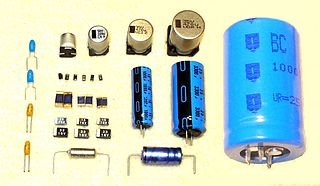
An electrolytic capacitor is a polarized capacitor whose anode or positive plate is made of a metal that forms an insulating oxide layer through anodization. This oxide layer acts as the dielectric of the capacitor. A solid, liquid, or gel electrolyte covers the surface of this oxide layer, serving as the cathode or negative plate of the capacitor. Because of their very thin dielectric oxide layer and enlarged anode surface, electrolytic capacitors have a much higher capacitance-voltage (CV) product per unit volume than ceramic capacitors or film capacitors, and so can have large capacitance values. There are three families of electrolytic capacitor: aluminium electrolytic capacitors, tantalum electrolytic capacitors, and niobium electrolytic capacitors.

A spark-gap transmitter is an obsolete type of radio transmitter which generates radio waves by means of an electric spark. Spark-gap transmitters were the first type of radio transmitter, and were the main type used during the wireless telegraphy or "spark" era, the first three decades of radio, from 1887 to the end of World War I. German physicist Heinrich Hertz built the first experimental spark-gap transmitters in 1887, with which he proved the existence of radio waves and studied their properties.

A variable capacitor is a capacitor whose capacitance may be intentionally and repeatedly changed mechanically or electronically. Variable capacitors are often used in L/C circuits to set the resonance frequency, e.g. to tune a radio, or as a variable reactance, e.g. for impedance matching in antenna tuners.
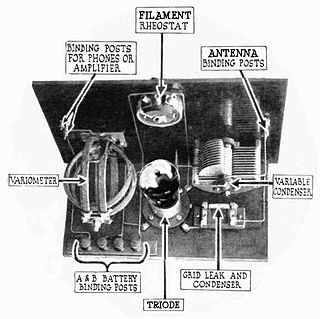
A grid leak detector is an electronic circuit that demodulates an amplitude modulated alternating current and amplifies the recovered modulating voltage. The circuit utilizes the non-linear cathode to control grid conduction characteristic and the amplification factor of a vacuum tube. Invented by Lee De Forest around 1912, it was used as the detector (demodulator) in the first vacuum tube radio receivers until the 1930s.

In electrical engineering, a synchronous condenser is a DC-excited synchronous motor, whose shaft is not connected to anything but spins freely. Its purpose is not to convert electric power to mechanical power or vice versa, but to adjust conditions on the electric power transmission grid. Its field is controlled by a voltage regulator to either generate or absorb reactive power as needed to adjust the grid's voltage, or to improve power factor. The condenser’s installation and operation are identical to large electric motors and generators.
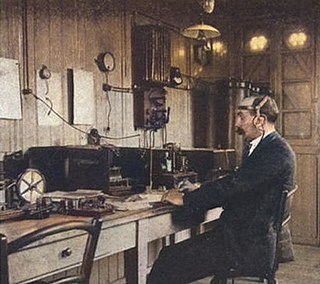
The invention of radio communication was preceded by many decades of establishing theoretical underpinnings, discovery and experimental investigation of radio waves, and engineering and technical developments related to their transmission and detection. These developments allowed Guglielmo Marconi to turn radio waves into a wireless communication system.

A capacitor is an electronic device that stores electrical energy in an electric field by accumulating electric charges on two closely spaced surfaces that are insulated from each other. It is a passive electronic component with two terminals.

Capacitor discharge ignition (CDI) or thyristor ignition is a type of automotive electronic ignition system which is widely used in outboard motors, motorcycles, lawn mowers, chainsaws, small engines, turbine-powered aircraft, and some cars. It was originally developed to overcome the long charging times associated with high inductance coils used in inductive discharge ignition (IDI) systems, making the ignition system more suitable for high engine speeds. The capacitive-discharge ignition uses capacitor discharge current to the coil to fire the spark plugs.
The Hammarlund Manufacturing Company was founded by Oscar Hammarlund in New York City, New York, United States in 1910. When the company was dissolved in 1973, it was among the USA's very oldest producers of radio equipment.

Silver mica capacitors are high precision, stable and reliable capacitors. They are available in small values, and are mostly used at high frequencies and in cases where low losses and low capacitor change over time is desired.
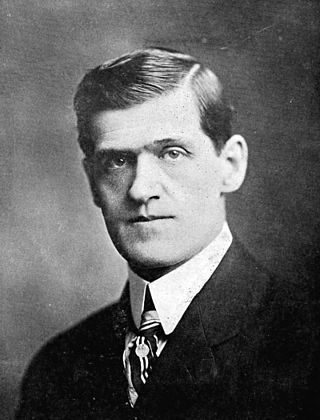
Archie Frederick Collins, who generally went by A. Frederick Collins, was a prominent early American experimenter in wireless telephony and prolific author of books and articles covering a wide range of scientific and technical subjects. His reputation was tarnished in 1913 when he was convicted of mail fraud related to stock promotion. However, after serving a year in prison, he returned to writing, including, beginning in 1922, The Radio Amateur's Handbook, which continued to be updated and published until the mid-1980s.

William Dubilier was an American inventor in the field of radio and electronics. He demonstrated radio communication at Seattle's Alaska–Yukon–Pacific Exposition on June 21, 1909; ten years before the first commercial station operated. A graduate of Cooper Union, he was the first to use sheets of naturally occurring mica as the dielectric in a capacitor. Mica capacitors were widely used in early radio oscillator and tuning circuits because the temperature coefficient of expansion of mica was low, resulting in very stable capacitance – mica capacitors are still used where exceptional temperature stability is needed.

KEMET Corporation, a subsidiary of Yageo Corporation, is an American company which manufactures a broad selection of capacitor technologies such as tantalum, aluminum, multilayer ceramic, film, paper, polymer electrolytic, and supercapacitors. KEMET also manufacturers a variety of other passive electronic components, such as AC line filters, EMI cores and filters, flex suppressors, electro-mechanical devices (relays), metal composite inductors, ferrite products, and transformers/magnetics. The product line consists of nearly 5 million distinct part configurations distinguished by various attributes, such as dielectric material, configuration, encapsulation, capacitance, voltage, performance characteristics, and packaging.

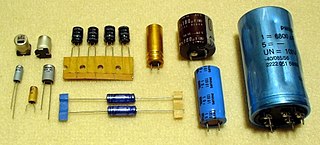
Aluminum electrolytic capacitors are polarized electrolytic capacitors whose anode electrode (+) is made of a pure aluminum foil with an etched surface. The aluminum forms a very thin insulating layer of aluminum oxide by anodization that acts as the dielectric of the capacitor. A non-solid electrolyte covers the rough surface of the oxide layer, serving in principle as the second electrode (cathode) (-) of the capacitor. A second aluminum foil called “cathode foil” contacts the electrolyte and serves as the electrical connection to the negative terminal of the capacitor.
Jackson Brothers, commonly known as Jackson Bros, was a firm known for its dominance of the variable capacitor market in the early days of radio broadcasting. Founded in 1923 to provide tuning capacitors for the growing home construction market, by the Fillmore family in Lewisham, England, the firm went on to manufacture a huge variety of the, mostly air-spaced, two or three gang, variable capacitors, that were at the heart of all radio receivers until the invention of the varicap diode, which replaced them, especially in VHF designs, and the frequency-synthesizer front ends that are now found in most radio receivers.















